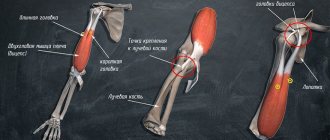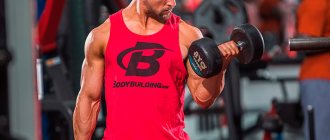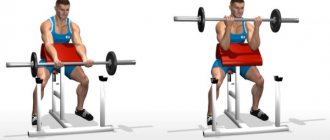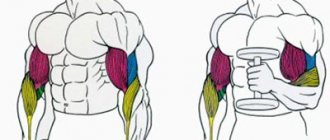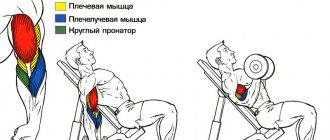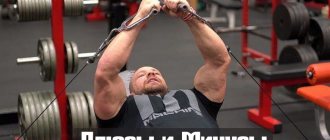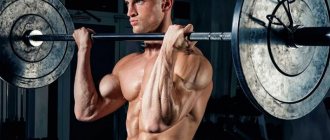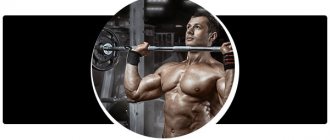Anatomy exercises
Lifting the barbell is aimed at developing both bundles of the biceps muscle of the arm - the biceps. The load is distributed unevenly, so the long (inner) beam does more work. Short (external) – loaded using other movements with additional weights.
Biceps exercises with dumbbells or a barbell are classified as isolating movements. Their action is maximally aimed at loading the biceps muscle, but not only. Before you start training, you need to figure out which muscles work in parallel:
- brachyradialis;
- anterior delta;
- brachialis;
- wrist extensors and flexors;
- round shoulder.
Lifting a barbell that is too heavy for your biceps or performing the exercise uncontrollably and quickly will cause irreparable damage to your joints. Uneven load, sudden movement, lack of warm-up before training can lead to muscle rupture. In such cases, further surgical intervention will be required.
Execution technique
Biceps curls allow you to achieve the maximum effect of developing this muscle if the correct technique is followed. The whole process can be divided into the following stages:
- Preparation. The necessary equipment (barbell, weights, clamps) is prepared in advance, taking into account the weight of the projectile for each approach.
- Choosing the optimal position. The bar is grasped with your hands in such a way that its width is symmetrical to your shoulders. The legs should also be shoulder-width apart and slightly bent. Elbows and hands are parallel to the body and pressed to the sides.
- Doing the exercise. Curling arms with a barbell in a standing position is performed due to the beneficial work of the biceps. Elbows and shoulders should be motionless. The barbell is smoothly raised to the chin with a slight delay at the peak point at the top, while taking a deep breath. After 1–2 seconds, the projectile should be lowered to its original position and exhaled.
The weight of the bar must be optimally selected so that the body is in a level position during the exercise. Breathing is also key, as it ensures the delivery of oxygen and nutrients to the muscle.
IPAF Strict Curl Rules
These rules are the official publication of the technical rules of the competition according to IPAF.
The rules were approved by the Presidium and came into force on January 1, 2019. Copying and publishing without official permission is prohibited!
General Rules: Sanctioning of Competitions and Results: Only recognizes results in the strict biceps curl that have been performed in accordance with these Technical Rules at an officially sanctioned competition by this organization. The IPAF sports federation registers records in Kazakhstan, Asia and the world for strict biceps curls. The weight on the barbell at all competitions is determined in kilograms. Time to complete the exercise is 1 minute. I Rules for performing a strict biceps curl of the IPAF Federation 1. The athlete stands facing the front of the platform.
The bar should be held horizontally at hip level. Palms facing forward, fingers clasping the bar. The distance between the index fingers should be no more than 81 cm. The legs should be level on the platform, on the same line parallel to the bar, the knees may be slightly bent. The distance from the athlete’s heels to the wall should not exceed 30 cm, arms are fully straightened. 2. The athlete in the starting position waits for the command of the Chief Judge. The command is given as soon as the athlete demonstrates readiness. The signal to begin the exercise is an upward movement of the hand and a loud command “Start”. 3. As soon as the command is given, the athlete must lift the barbell by bending his elbows. You should bend your arms until your elbows are completely bent. The bar at this moment should be at the level of the chin or throat. The shoulders are pulled back, the shoulder blades are pressed against the wall, and the buttocks are also pressed against the wall throughout the entire exercise. 4. The legs and hips should not be used in any way to generate propulsion to facilitate the exercise. 5. Upon reaching the final position, the head judge gives the command “Down”. The command is not given until the bar is locked in its final position. 6. Any upward movement of the barbell or any deliberate attempt to lift the barbell is considered a used attempt. 7. If the athlete was given a weight greater than the ordered one, then: - if this attempt is successfully completed, the weight is credited to the athlete; — in case of unsuccessful execution, the athlete is given an additional attempt at the end of the current approach; 8. If the athlete was given a weight less than the ordered one, then: - if this attempt is successfully completed, the athlete can either accept the result of this attempt, or he may be given an additional attempt at the end of the current approach; — in case of unsuccessful execution, the athlete is given an additional attempt at the end of the current approach; 9. The minimum step for changing the weight of the barbell is 2.5 kg. In a record attempt, the weight of the barbell must be at least 1 kg higher than the existing record. 10. The winner in the individual competition in each weight category is determined by the highest weight lifted. If two or more athletes achieve the same result, the lighter athlete is classified higher than the heavier one. If, during the weigh-in, the registered athletes find themselves with the same body weight, and at the end of the competition they show the same result, the participants will be re-weighed, and the athlete whose weight will be lighter will take a higher place. Reasons why an attempt to perform an exercise may not be counted. 1. Failure to comply with the signals and commands of the senior judge on the platform.
2. Any downward movement of the bar until it reaches the final position. 3. Separation of the shoulder blades and/or buttocks from the wall. 4. Moving the feet on the platform, or rocking the feet from heel to toe. 5. Using your hips to create a push to make it easier to start the lift. II. AGE AND WEIGHT CATEGORIES 2.1 Age categories. Men: Boys: from 13 to 19 years old (inclusive) Juniors: from 20 to 23 years old (inclusive) Open: from 24 to 39 years old (inclusive) In relation to athletes who have reached the age of 13 years, the following condition applies: the athlete must reach age 13 by the day of the competition. On the day a youth turns 20, he is no longer eligible to compete in the youth category. On the day a junior turns 24, he is no longer eligible to compete in the junior category. Note: At the discretion of the competition organizers, it is possible to combine age and weight categories in order to increase the value of competition titles. 2.2 Weight categories. Men: 60.0 kg – from 56.01 kg to 60.0 kg; 67.5 kg – from 60.01 kg to 67.5 kg; 75.0 kg – from 67.51 kg to 75.0 kg; 82.5 kg – from 75.01 kg to 82.5 kg; 90.0 kg – from 82.51 kg to 90.0 kg; 100.0 kg – from 90.01 kg to 100.0 kg; 110.0 kg – from 100.01 kg to 110.0 kg; 125.0 kg – from 110.01 kg to 125.0 kg; Note: At the discretion of the competition organizers, it is possible to combine age and weight categories in order to increase the value of competition titles.
III Records Records are recorded in excess of 1 kg, relative to the existing record result. An additional record attempt is given to the athlete only if the third attempt is successful (counted by the judges on the platform). Only registered athletes competing at the tournament can attempt to set a record in an additional attempt (i.e., an athlete with a zero result after three attempts, but remaining at the tournament as a guest, cannot set a record in the fourth attempt).
IV. PERSONAL EQUIPMENT ITEMS An athlete is not allowed to participate in the tournament without a wrestling suit. Informing athletes regarding the use of permitted equipment (if any) begins one hour, but no later than half an hour before the start of the competition. If a new record is set, the central judge must immediately, immediately after the approach, check the athlete’s equipment, the weight of the barbell and the equipment on the platform. If an athlete uses prohibited equipment, the record is canceled and the attempt is also considered unsuccessful. 4.1. The racing overalls should consist of a solid, single-layer, elastic, soft material that does not provide additional support to the muscles. 4.2. Prohibited: Elbow pads, squat suits, deadlifts and other support suits. Also prohibited are any patches, pads or strips connected to each other by seams, with the exception of factory-made ones. Any seams, overlays, inserts or other details that, in the opinion of members of the technical committee, jury or judges, are used in a leotard solely to increase rigidity will serve as grounds for prohibiting the use of such a suit in competition. 4.3. The suit worn by the athlete must fit (tightly) the body without any sagging. 4.4. The straps of the suit must be worn over the athlete's shoulders during all exercises in competition. 4.5. A competitive wrestling jumpsuit can be: - any color, plain or multi-colored. — the costume may bear a distinctive sign, emblem, coat of arms and (or) the name of the participant’s country, national federation (association) or sponsor, the participant’s first and last name. — Inscriptions of an offensive nature or discrediting the sport are prohibited. 4.6 The T-shirt must fit freely on the athlete to ensure that it does not provide any physical support. The T-shirt sleeve should not cover the elbow. 4.7 Belt (belt). . The participant can use a belt (belt). It is worn over overalls. The maximum belt width should not exceed 10 cm / 4.12 inches at its widest point. The thickness of the belt cannot be more than 13 mm / 1/2 inch. There are no restrictions regarding the design and materials from which the belt is made. 4.8 Shoes. The athlete must wear shoes while performing exercises. The use of shoes with metal spikes and strips, as well as sneakers, slates, and flip-flops is prohibited. 4.9 Wrist wraps. Bandages should not exceed 50 cm in length and 8 cm in width. Only one pair of bandages is allowed. Bandages with Velcro and a thumb loop are acceptable. The loop should not be worn while lifting the barbell. The width of the winding from the middle of the wrist upward (on the forearm) is no more than 10 cm.
V Exceptions: Any physical abnormality of an athlete that may prevent full compliance with the technical rules must be reported and explained to tournament officials. This must be done before the athlete's flow begins. The athlete, officials and platform judges must discuss all details and adapt the platform to the athlete. For example, deafness, blindness, or abnormalities of the limbs and/or joints that interfere with proper bending or grip.
VI Misconduct Any athlete or coach who discredits the sport, insults other competitors, judges or tournament organizers with his behavior or words must be officially warned. If the violation continues, the jury, or in its absence the judges, may disqualify the athlete or coach and order them to leave the competition area.
Insulting Federations, judges and tournament organizers on the Internet and at competitions will result in lifelong disqualification of the athlete and/or coach.
VIII INSURANCE The Federation does not provide athletes, spectators and competition officials with insurance policies against accidents, medical and compulsory insurance. This is the responsibility of the competition organizers. The Federation does not assume any liability for damage, injuries, individual injuries, including deaths, during the competition. Proof of insurance is the insurance policy obtained during the competition.
Varieties
Working on biceps with a barbell should be comfortable and safe, which is why there are different types of barbells. They can vary in thickness, length, weight, and shape. To lift heavy weights without further injury to the wrists, use the EZ curved bar. It provides a comfortable grip and allows you to fully feel your biceps during training. Working with such equipment is an excellent way to prevent injuries, but it is recommended to alternate between different types of equipment.
The width of the arms depends on the physiological characteristics of the athlete. The distance should be optimal and ensure the most comfortable and productive exercise. There are 3 conventional grip width options:
- Standard. Place your hands shoulder-width apart (recommended for working with optimal barbell weight).
- Narrow. The hands are as close to one another as possible. In this case, the EZ bar is perfect, placing the maximum load on the long head of the biceps.
- Wide. The optimal choice for working the inner (short) head of the biceps muscle of the arm.
These grip options are nominal, so they will be individual for each athlete. The emphasis here is solely on the load of different muscle heads. The secret to success is alternating these techniques; it allows you to expose your biceps to maximum stress, which has a positive effect on its growth.
Standard
Narrow
Wide
It is also useful to lift biceps curls while standing using a reverse grip. This allows you to reduce the stress on your elbows. Performing the exercise allows you to put a good load on the forearms, brachialis, and brachyradialis. The anterior deltoid muscles and forearms are included in static work.
The undeniable advantages of this exercise are:
- Lifting the barbell onto the biceps using the reverse grip method allows you to load the remaining muscles of the arms, which are poorly used when performing movements in standard ways (for example, the brachialis makes the arm visually rounder and larger, and powerful forearms add solidity to the overall appearance of the athlete and enhance the static strength indicators of the arms).
- The reverse grip is an excellent preventive measure. It is suitable for the development of biceps with long-term “stagnation” in its growth.
This type of training should be practiced every 2 arm workouts. It is better to focus on this exercise at the end of the session, which will allow you to load your arms as effectively as possible, which will lead to an increase in their volume.
The strict standing barbell lift is the most effective option for training the biceps arm. Lifting the projectile occurs due to maximum tension of the biceps, isolating all auxiliary muscles. The press is performed similarly to the basic movement, but the bodybuilder presses his back against a flat vertical surface, which allows for maximum load on the flexor muscles. Recently, the exercise has become so popular that special competitions are held for it.
Strict barbell curls also eliminate “cheating,” a deliberate violation of exercise technique when an athlete uses additional muscle groups to do a few more repetitions.
How to prepare
The biceps muscle is 1/3 of the entire arm. The rest of the muscle mass is in the triceps, deltoids and forearms. The triceps is an antagonist muscle and performs the opposite function - extending the arm. Its training is a direct guarantee of success for the development of biceps.
When preparing for a full biceps curl, you should consider the following points:
- mandatory warm-up before each workout should become a habit;
- establishing the correct technique with minimal weight;
- training grip strength, wrist performance;
- competent alternation of arm training with other muscle groups;
- alternating the grip method, the number of repetitions with different loads and the method of performing the exercise - sitting, standing, strict lifting, “hammers”.
At first, you can train quite successfully with your own weight. Regular push-ups and pull-ups on the horizontal bar are perfect here. You can also use various simulators. This is great training for the biceps.
One of the key points when playing sports is proper nutrition. Strong ligaments and tendons are especially important for biceps curls, so you should eat the right amount of healthy fats.
Warm-up
Establishing the correct technique
Grip strength training
Alternating workouts
Alternating grip method
Proper nutrition
Interesting Facts
Tsyplenkov Denis - Russian arm wrestler, absolute champion of the World Cup, recorded a world record in standing biceps curls, lifting 140 kg for 5 repetitions and 160 kg for 1 repetition. Yes, of course, many will say that there is no proper technique here, but a certain percentage of athletes in deadlifts and squats with a barbell have lower results than Denis does for biceps curls.
Arnold Schwarzenegger, I think, needs no introduction, in his best years, when his weight was about 115 kg, and his arm circumference was 54 cm, the maximum working weight for lifting the biceps barbell was 120 kg.
That's all for me, I wish you that your T-shirts in the arm area are bursting at the seams. Well, as promised above, I offer a useful video for viewing. Good luck and health!
Contraindications and common mistakes
The described exercise is not suitable for all athletes. There are a number of restrictions:
- the presence of injuries to the elbow joints, wrists and shoulder girdle;
- hernias and protrusions of the vertebral region (in mild forms, working with the bar in a sitting position is allowed);
- It is not recommended to lift a heavy projectile without wrist straps if you have wrist injuries;
- This exercise should be excluded for a while in the presence of inflammatory muscle processes or during a common cold, since the ligaments and tendons are maximally depleted.
Before starting serious training with weights, you should consult a specialist, take tests and undergo an examination to determine the possibility of engaging in this type of physical activity.
All progress from training can be significantly hampered by the following errors, which are of a technical nature:
- Excessive body movements while performing the exercise. Doing a barbell curl while standing is much easier than doing it in a sitting position. In this case, the legs help to do useful work, generating additional energy. The exercise should be performed under control, excluding as much as possible the work of other muscles of the body.
- Work at incomplete amplitude. This mistake is especially common for beginners. With such training, non-professional athletes quickly load their biceps, and they begin to move their body.
- Lifting the bar as high as possible. In this case, upon reaching the maximum upper point, the elbows will be pressed tightly to the sides.
- Biceps training does not start with lifting a barbell. This exercise should be done very first in training the biceps muscle, since a large supply of energy allows you to load the muscle well and accelerate its growth.
Taking into account the mistakes described above and not repeating them, your progress from classes will increase significantly. Proper construction of the training process, sequence of exercises and number of repetitions also have a positive effect on the development of biceps.
Presence of injuries to the elbow joints
Hernias and protrusions of the spine
Wrist injuries
Inflammatory muscle processes
How to train
Beginning bodybuilders should train three times a week. For muscles to grow, they must recover. Train your biceps once a week. As you progress, you can switch to 2-time double-headed training.
Gradually add the weight of the barbell and the number of flexions and extensions.
Remember: to pump up muscles and create relief, you need a large number of repetitions and exercise through strength. Do several approaches with the optimal number of presses for you.
Improved efficiency
To improve the quality of biceps training, you should choose the optimal weight of the projectile, allowing you to concentrate on lifting it. Bending the arms can not be done to the full amplitude to prevent complete relaxation of the arm muscles. Alternating between different biceps workouts with different grips will also help increase your progress in biceps development. It is important to take into account proper rest, since the biceps muscles of the arms are also involved in other exercises. Correct technique and breathing are the key to getting a good result.
It is especially important to carry out maximum contraction of the biceps when the barbell is at the top point. The load must be selected in such a way that the last few repetitions cause a burning sensation in the muscle. This kind of work “to failure” perfectly stimulates the biceps to grow.
Rest between sets should be no more than a minute. You can also use special heart rate monitors that allow you to track your heart rate. The heart rate should not fall below 100 beats per minute.
People who want to quickly build up their biceps should definitely work out with a barbell. This exercise will strengthen your arm muscles. In this case, it is necessary to follow the execution technique and safety rules.
Choose the optimal projectile weight
Correct technique and breathing
Rest between sets no more than a minute
